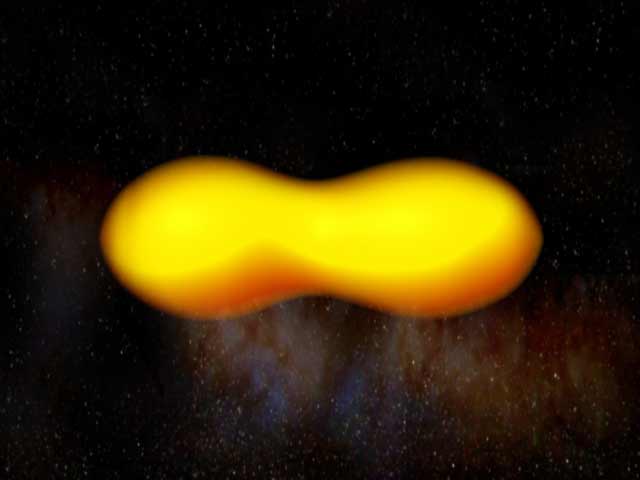Huge 'Peanut' Stars Share Material

A pair of newfound stars orbit each other so closely that they share material, taking on the appearance of a giant peanut in space.
In fact, a second freshly examined system has the same two-lobed look. The systems were announced today and are the first and second of a new class of objects.
The first system found is 13 million light-years away — relatively close by cosmic standards — inside a small galaxy called Holmberg IX. Both stars are very bright, yellow stars about 15 times the mass of our sun. In the pair's orbital cycle, one star moves in front of the other, blocking its light from our vantage point, so astronomers see one star, then two, then one, and so on, as illustrated in a video.
The study, funded by the National Science Foundation, was published recently in Astrophysical Journal Letters. The observations were made with the Large Binocular Telescope (LBT) on Mt. Graham in Arizona.
In looking for other examples, José Prieto, Ohio State University graduate student and lead author on the journal paper, found another one much closer, less than 230,000 light-years away in the Small Magellanic Cloud, a small galaxy that orbits our own Milky Way. The star system had been discovered in the 1980s, but was misidentified. When Prieto re-examined the data that astronomers had recorded at the time, he saw that the pattern of light was very similar to the one they had detected in the first pair. The stars were even the same size — 15 to 20 times the mass of the sun — and melded together in the same kind of peanut shape. The system was clearly a yellow supergiant eclipsing binary, the new name given to this class of objects.
"We didn't expect to find one of these things, much less two," said Kris Stanek, associate professor of astronomy at Ohio State and a colleague in the study. "We needed the 8.4-meter LBT to spot the first binary, but the second one is so bright that you could see it with binoculars in your back yard. Yet, if we hadn't found the first one, we may never have found the second one."
The finds may help solve another mystery. Of all the supernovas that have been studied over the years, two have been linked to yellow supergiants, but theory doesn't predict any should be yellow supergiants.
Get the Space.com Newsletter
Breaking space news, the latest updates on rocket launches, skywatching events and more!
Over millions of years, Prieto explained, a star will burn hotter or cooler as it consumes different chemical elements in its core. The most massive stars swing back and forth between being cool red supergiants or hot blue ones. They spend most of their lives at one end of the temperature scale or the other, but spend only a short time in-between, where they are classified as yellow. Most stars end their life in a supernova at the red end of the cycle; a few do at the blue end. But none do it during the short yellow transitional phase in between.
At least, that's what astronomers thought.
Prieto, Stanek and their colleagues suspect that yellow binary systems like the ones they found could be the progenitors of these odd yellow supernovas.
"When two stars orbit each other very closely, they share material, and the evolution of one affects the other," Prieto said. "It's possible two supergiants in such a system would evolve more slowly and spend more time in the yellow phase — long enough that one of them could explode as a yellow supergiant."
- Video: The 'Peanut' Stars
- The Strangest Things in Space
- Top 10 Star Mysteries
Join our Space Forums to keep talking space on the latest missions, night sky and more! And if you have a news tip, correction or comment, let us know at: community@space.com.

Space.com is the premier source of space exploration, innovation and astronomy news, chronicling (and celebrating) humanity's ongoing expansion across the final frontier. Originally founded in 1999, Space.com is, and always has been, the passion of writers and editors who are space fans and also trained journalists. Our current news team consists of Editor-in-Chief Tariq Malik; Editor Hanneke Weitering, Senior Space Writer Mike Wall; Senior Writer Meghan Bartels; Senior Writer Chelsea Gohd, Senior Writer Tereza Pultarova and Staff Writer Alexander Cox, focusing on e-commerce. Senior Producer Steve Spaleta oversees our space videos, with Diana Whitcroft as our Social Media Editor.









